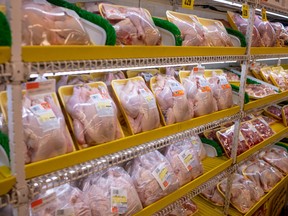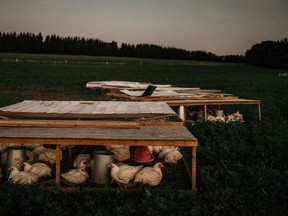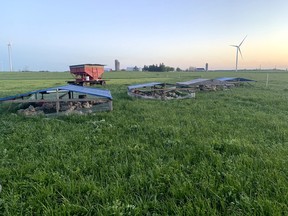Why premium chicken is so expensive in Canada
[ad_1]
Take heart, chicken lovers: not every bird is of a similar feather and some farmers have reasons to justify their higher pricing

Article content
Siobhan Morris had a few issues she hoped to address after work in early January. The first concerned her fridge, which was practically empty following the holidays, while the second was her diet, which had gone the way of gluttony and required an overhaul to get the veteran Toronto journalist back to eating healthily to start the new year.
Advertisement 2
Article content
She had a list of pre-planned meals in hand as she entered a Loblaws supermarket in the city’s west end to stock up for the week, and among the dinner options was honey sriracha chicken. What she found in the meat department was an object of genuine consumer bafflement: a five-pack tray of boneless, skinless chicken breasts for $37.03 — or $26.87 per kilogram.
Article content
Store employees had not made an error and mislabeled the package. The $37 chicken was, indeed, $37, and Morris, in her astonishment, took a photo of the package and posted it to Twitter along with an expression of shock: “I beg your pardon.”
Four weeks later, the tweet that “will not die,” as Morris describes it, has been viewed a whopping 4.5 million times. Loblaw Cos. Ltd. told her and her CTV News colleagues that the chicken was a “premium” product, and subject to the same inflationary pressures driving up costs across the economy.
Advertisement 3
Article content
Ever since, a stink over pricey chicken breasts has been simmering away, a kerfuffle that John Moylan, a small-scale producer of premium, pasture-raised, antibiotic-free chicken, that he sells direct to consumers — charging about $28 per kilogram for boneless, skinless breasts — was unaware of.
Shoppers hoping to better educate themselves about grocery chain chicken prices could try reading labels, some of which advertise chicken as being “hormone-free.” And that is true enough, but hormones have been banned in all Canadian poultry since 1963. It turns out your hormone-free, premium-priced supermarket chicken is more or less just another chicken dressed up with a marketing hook. But take heart, chicken lovers: not every bird is of a similar feather and some farmers have reasons to justify their higher pricing.
Advertisement 4
Article content
“You mentioned this tray of $37 chicken breasts, but what we are producing is a different product altogether,” Moylan said on a late January afternoon as he fed two of his daughters — he and his wife Sarah have four girls — a snack of cucumbers and hummus.
His operation is about two hours west of Toronto, and its 5 Chicks and a Farmer moniker reflects his family situation. Unlike most city slickers, he understands the costs involved in raising a premium bird, from day-old hatchling to vacuum-packed, ready-to-be-sold chicken, and he offered his assurances that if anybody is getting rich off the enterprise, it certainly isn’t him.
“Chicken is a lot of work, and we couldn’t be doing it if we were charging any less,” said Moylan, who also raises cattle and pigs for consumption.
Advertisement 5
Article content
The year-over-year price of fresh and frozen chicken increased by 11.1 per cent in 2022, according to Statistics Canada. The government number crunchers don’t keep track of how much chicken Canadians consume per capita, but it reports that 22.26 kg of boneless chicken, including stewing hens, was available for consumption per Canadian in 2021, while chicken producers generated $3.3 billion in revenues.

Moylan’s operation is not factory scale. His birds are certified “artisanal” by the Chicken Farmers of Ontario, and so consumers won’t find them at the meat counter in Loblaws or any other grocery store. The artisanal designation caps his production at 3,000 chickens per year, and he raises them in batches of 750, purchasing the birds as day-old hatchlings from Frey’s Hatchery Ltd. in St. Jacobs, Ont., for about $2,000 a lot.
Advertisement 6
Article content
Baby chicks are initially kept in a barn heated to 35 C and sleep on wood shavings. The barn temperature is lowered in five-degree increments each week until the chickens are carried out in “chicken tractors” to the pasture after four weeks. These moveable coops house about 75 birds each, and lack floors, allowing the chickens to peck for insects and munch on grass and clover.
Moylan moves the huts daily, so his chickens have fresh pasture to peck at. But the bulk of their diet consists of a non-genetically modified soy-and-corn blend he purchases by the tonne from Jones Feed Mill Ltd., in Linwood, Ont.
Mike Edwards, the chief executive there, said that every “input” across the board in his business has increased over the past eight months: the corn and soy he buys from farmers to make feed, the wages he pays, the fuel for his trucks, even cardboard boxes have ballooned in price.
Advertisement 7
Article content
The war in Ukraine, drought in the United States and ongoing supply chain snafus have all helped push global soybean and corn prices to near record highs.
For Moylan, that means a 25-kg bag of non-GMO chicken feed purchased today costs $22, or 30 per cent more than it did 18 months ago. Chickens eat a lot of feed, about half a bag each over the eight weeks or so it takes them to reach a market weight of around four kilos.

Feed costs, plus the initial outlay for chicks, represent about 70 per cent of a producer’s costs, Edwards said. Moylan has one full-time employee, aside from himself, and when the chickens are judged ready for the barbecue, he pays some local teenagers $17 an hour to help him catch the birds in an operation that starts at dusk when they are most docile.
Advertisement 8
Article content
He then hauls them by trailer behind a 2009 pick-up truck to an abattoir — burning $150 in gas. Once processed, the chickens are kept in cold storage awaiting sale, as a fresh flock of 750 arrives on the farm, and the eight-week cycle begins anew.
Sales are couriered direct to customers — another expense — as is marketing the product. Also in the mix: mortgage payments on a 150-acre property, hydro bills, insurance, machinery and building maintenance costs. At every turn, there is another financial bite, all but guaranteeing that whatever profit is left at the end of the day gets plugged back into the farm.
“We are keeping the bills paid,” Moylan said.
The payoff for customers is delicious chicken. Erica Tessier, a drama teacher in Wellesley, Ont., is a fan, because of the taste — she describes it as meatier and more flavourful than grocery-store bought fare — but even more so for how the chickens are raised.
Advertisement 9
Article content
-
![Inflation in food retail prices has stayed stubbornly high, hovering around 11 per cent for the last four months.]()
Why your grocery bills remain high even as inflation slows
-
![A person pushes a shopping cart through the produce section of a grocery store in Toronto.]()
Grocery business to have first-ever code of conduct by end of 2023: Agriculture minister
-
![James Miele, warehouse manager at a site where the Canadian Dairy Commission maintains a strategic reserve of butter.]()
Inside Canada’s national butter reserve, the government stockpile that ensures you can do your holiday baking
“It is not factory farming,” she said.
Moylan’s buyers typically fall into three categories: those in it for the taste, the animal welfare crowd and the health-conscious types who view the birds as more nutritious than their barn-raised relatives.
Alas, on the evening of Jan. 3, Siobhan Morris was short of options, and patience, as she scanned the meat counter at Loblaws. It was 7 p.m. She was famished, but not quite hungry enough to shell out $37 for five chicken breasts, although she did opt for a lighter weight tray of breasts — at the same price per kilogram — since she wasn’t in the “mood to go hunting for cheaper chicken.”
There are no real discounts in Moylan’s freezer, but there is an Ontario chicken farmer with bills to pay, a family to feed and yummy birds to send via courier to your front door.
“We are getting a little low on chickens,” he said. “But we have some pigs going in next week.”
• Email: joconnor@nationalpost.com | Twitter: oconnorwrites
[ad_2]
Source link






Comments are closed.